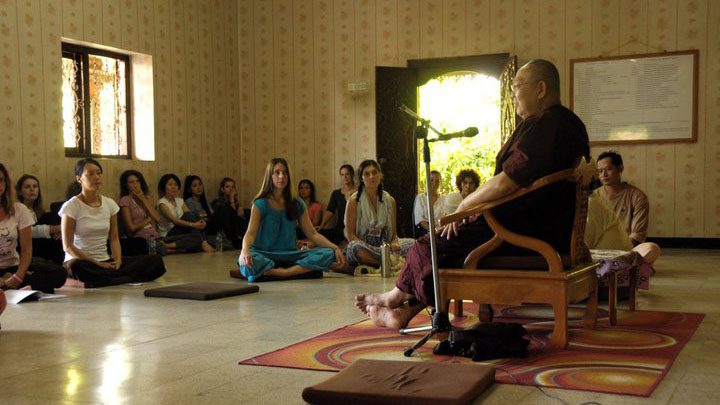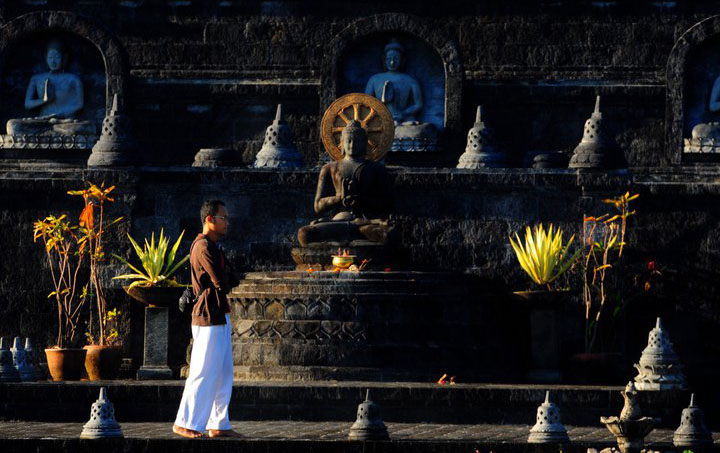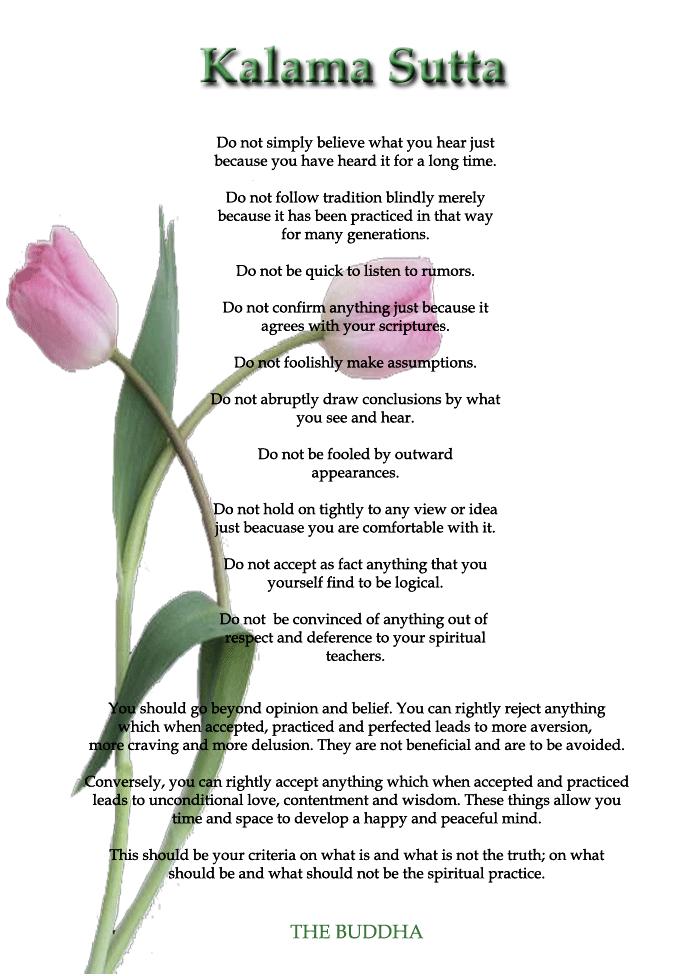Affiliate disclosure: Some of the links below are affiliate links, meaning, at no additional cost to you, I will earn a commission if you click through and make a purchase. As an Amazon Associate I earn from qualifying purchases.
You might have ever heard of vipassana meditation. It’s a kind of meditation practice that’s often talked about amongst meditation practitioners and gaining popularity in the world.
More and more people are interested in vipassana meditation and eager to learn and try it out. That’s one of the reasons for its gaining popularity. Nowadays, vipassana retreats are conducted regularly around the world.
What is vipassana meditation? What’s so unique about it?
Those are the questions I get asked a lot.
My first vipassana retreat was back in 2009. Since then, I’ve attended several more. I’m a big fan of it. And, I’ve been practicing daily ever since.
So, in this post, I’ll share with you what I’ve been learning so far to answer those questions as best as I can, what vipassana meditation is, and how you can practice it.
Table of Contents
What is vipassana meditation?

Vipassana is a Pali term often translated as insight or clear-seeing.
It is deeply rooted in the Buddhist tradition.
But, because of its universal essence, its practitioners come from many different spiritual and religious backgrounds. That’s the fact I always found in retreats I attended. A lot of the participants I met are not Buddhist.
You don’t need to be a Buddhist to practice vipassana.
Vipassana is one of the two kinds of meditation the Buddha taught, the other one being samatha.
I’d like to touch samatha a bit to help you better understand vipassana.
While samatha is a focus or concentration-based meditation, vipassana is a mindfulness-based meditation, commonly translated as insight meditation.
In samatha meditation, you train yourself to focus your mind on a single object to achieve one-pointedness. That way, the mind becomes calm, stable, and tranquil.
The nature of the meditation object in samatha meditation is usually conceptual and static.
In vipassana meditation, you train yourself to be mindful of your mind and body continuously with the right attitude, to gain insights into their nature, to see things as really they are, to understand the true nature of reality.
Check out the right attitude for meditation.
The object of vipassana meditation is “the process” of mind and body, which is always in a constant flux of change. Therefore, its nature is factual and dynamic.
In other words, the object in vipassana meditation is anything that is happening in the mind and body.
The function of an object is to be known, to be acknowledged, to be aware of.
The right attitude means we practice seeing the object as nature or a natural process instead of me or mine.
We practice not clinging to and not rejecting any object.
In vipassana, you don’t need to choose an object or prefer one over another.
Because the object is not really important. Being mindful of it continuously with the right attitude is. The observing mind that is aware of the object is of the utmost importance.
We practice seeing objects as they are. We acknowledge them as they arise, as they stay, and as they pass away.
All objects come and go. That’s their nature. We’ll be able to see them that way if we don’t hold on to them; if we don’t love or hate them; if we don’t indulge in or get involved in them.
When being observed mindfully with the right attitude, any object is the right object.
By maintaining awareness of the object with the right attitude, in due time, you’ll gain an understanding of the workings of the mind.
In the process, you’ll learn more about yourself, your inner being.

Now, this is just as food for thought, the true nature of reality is impermanence, un-satisfactoriness, and non-self. They are the three marks of existence.
At this point, we don’t need to concern ourselves with those things.
Those three marks of existence are not for satisfying intellectual hunger. They’re meant to be realized in meditation through direct experience.
That understanding or insight will, in turn, end dukkha, commonly translated as “suffering,” by uprooting its cause, which is avijja, commonly translated as ignorance or delusion.
I prefer “un-satisfactoriness” instead of “suffering” to describe dukkha because “suffering” implies too narrow of a meaning.
What is delusion?
That is quite a big topic. But, let me give you some examples:
- Believing you are your body.
- Believing you are your feeling.
- Believing you are your thought.
- Believing you are your memory.
- Believing the mind and body are permanent.
All the above are examples of delusions or wrong views. Holding on to them causes us dukkha.
All things are mental and physical phenomena that are always in a constant flux of change. They arise and cease. They are natural processes. In vipassana, we practice seeing them as they are.
You’ll rarely find if at all, the term “vipassana” in the collection of discourses (Sutta Pitaka). You’ll only find it in the collection of higher teaching (Abhidhamma Pitaka).
The practice itself is based on the Satipaṭṭhāna Sutta and the subsequent Mahāsatipaṭṭhāna Sutta of the Pali Canon. It uses four foundations to develop mindfulness, which are:
- Mindfulness of the body (kāyānupassana)
- Mindfulness of the feeling (vedanānupassana)
- Mindfulness of the mind (cittanupassana)
- Mindfulness of the mental formation (dhammanupassana)
Some people believe samatha practice is a carry-over from previous or existing tradition at the time of the Buddha.
Vipassana, on the other hand, is commonly believed to be the practice the Buddha originally taught, hence the emphasis and popularity.
However, over the years, the dichotomy between samatha and vipassana seems to have gone a little bit too far.
The fact is, you cannot separate those two practices as clear-cut.
You need to develop mindfulness and focus in balance, with a bit more emphasis on mindfulness.
You need mindfulness to hold your focus, preventing it from drifting. And, you need focus for your mindfulness to penetrate the object, to go deeper.
Having said that, you need to put more emphasis on mindfulness.
Focus is a mental faculty you can develop by force, by disciplining yourself.
Mindfulness, on the other hand, is a delicate thing. Developing it by force won’t work. You can only cultivate it with a gentle approach, maintaining its continuity.
Some teachers teach samatha as a preparation for vipassana. Some others teach vipassana to go hand-in-hand with samatha.
I’ve noticed that even at retreat centers that use the direct vipassana approach, they usually have included the necessary samatha element in their training like anapanasati (mindfulness of breathing), and, sometimes, metta bhavana (loving-kindness meditation).
Check this article on mindfulness vs concentration by Bhante Gunaratana for a more in-depth explanation.
You may also want to learn the effects of too much mindfulness.
How can you practice vipassana?

If this is the first time you’re about to learn and practice vipassana, I’d recommend you attend a 10-day vipassana retreat. Although shorter duration ones are also available, I’d suggest you take at least the 10-day retreat.
In my experience, 10-day is barely an introduction.
If you try to learn on your own or from YouTube, I’m afraid you’ll risk missing a lot of the essence and end up wasting your time.
You’ll have a lot of questions during your practice. You’ll need a competent teacher to answer them.
On top of that, a retreat can provide a conducive environment for such training that beginners mostly need.
As for the posture, you can use several postures like sitting, walking, as well as standing.
Don’t worry if you think you’re not flexible enough to sit in that iconic lotus or half-lotus position. You can use a chair.
In retreats I attended, we’re also taught to maintain awareness in everything we do, not only when we’re doing our sitting, walking, and standing. We practice being mindful when we’re eating, cleaning our rooms, washing our clothes, taking a shower, etc. Those are the daily-activity posture.
In other words, we practice from the moment we wake up until the moment we fall asleep. That’s the duration of our daily practice.
Some centers might discourage the lying-down posture because of the susceptibility to falling asleep, especially for beginners.
Check my actionable tips on how to stop falling asleep during meditation here!
Part of the tradition, usually, they’ll require you to undertake and uphold the eight precepts during the retreat:
- Abstinence from taking lives (yes, even mosquitos and ants)
- Abstinence from taking anything which is not given
- Abstinence from sexual misconduct
- Abstinence from speaking untruthfully
- Abstinence from consuming intoxicants
- Abstinence from taking food at the wrong time.
- Abstinence from dancing, music, visiting shows, flowers, make-up, the wearing of ornaments and decorations.
- Abstinence from a tall, high sleeping place
The reason is not purely moral such as exercising restraint, etc. but also technical. It helps in maintaining mindfulness and focus big time.

Also part of the tradition is the practice of noble silence where all participants restrain from talking and any other form of communication.
Not only does it help maintain a conducive environment, but it also technically supports the practice.
You can still talk to management if necessary.
And, you’ll regularly talk to the teacher during interviews.
A lot of participants reported that they struggled and found it hard to endure their first ten days.
So, be prepared and commit yourself to endure until the finish, or you’ll miss the lessons.
You can begin by researching meditation centers whose teaching is based on the Satipaṭṭhāna.
In no particular order, some of the popular ones are:
I attended several of Sayadaw U Tejaniya’s retreats. His teachings put more emphasis on the cittānupassanā (the third Satipaṭṭhāna). I find it very clear and makes a lot of sense, and the technique works for me very well.
You’ll just need to find the one that suits you the best.
Now, the question is, how do you know if you’re following the right teaching or you’re on the right path?
The Buddha was once asked this similar question in ancient time by the people of the Kālāma clan in the Kālāma Sutta.
In summary, the people of the Kālāma clan asked the Buddha for advice: they say that many wandering holy men and ascetics pass through, expounding their teachings and criticizing the teachings of others. So whose teachings should they follow?
The Buddha gave this list of criteria:
Do not simply believe what you hear just because you have heard it for a long time.
Do not follow tradition blindly merely because it has been practiced in that way for many generations.
Do not be quick to listen to rumors.
Do not confirm anything just because it agrees with your scriptures.
Do not foolishly make assumptions.
Do not abruptly draw conclusions by what you see and hear.
Do not be fooled by outward appearances.
Do not hold on tightly to any view or idea just because you are comfortable with it.
Do not accept as fact anything that you yourself find to be logical.
Do not be convinced of anything out of respect and deference to your spiritual teachers.
You should go beyond opinion and belief. You can rightly reject anything which when accepted, practiced, and perfected leads to more aversion, more craving, and more delusion. They are not beneficial and are to be avoided.
Conversely, you can rightly accept anything which when accepted, practiced, and perfected leads to unconditional love, contentment, and wisdom. These things allow you time and space to develop a happy and peaceful mind.
This should be your criteria on what is and what is not the truth; on what should be and what should not be the spiritual practice.
The Buddha

Takeaways
The important mental faculty we’re cultivating in vipassana practice is mindfulness (Pali: Sati).
We develop mindfulness by maintaining its continuity. We cannot develop it by force.
That means mindfulness needs to be exercised in all of our activities continuously, at all times, not only during sitting meditation.
That means we need to do it in a natural and relaxed way. We need to conserve our energy.
When mindfulness is gaining momentum and becoming more continuous, we begin to “see” things (mind and body) as they are: nature, natural processes. We see them come and go. None of them are permanent.
In due times, when the required conditions are met, insight will arise.
As a result, attachment to mind and body gets weakened. Dukkha gets weakened. Delusion is being uprooted gradually.
I’d like to add one important point.
The arising of that insight is a natural process that cannot be forced. So, avoid drawing any conclusions. Otherwise, it would just be another delusion.
Remember to have the right attitude when practicing. See meditation objects as natural processes, remember to not identify yourself with them. Don’t hate or reject objects, but also don’t love or cling to them.
It’s not the object that is important. It’s the observing mind that is aware of it that is important.
Have no goals when practicing. Goals will do nothing other than adding unnecessary pressure in the mind that hinders progress.
The key to progress in vipassana meditation is the consistency and regularity of practice. Meaning, you need to habituate it, make it part of your lifestyle.
If you made it this far, I hope now you know what vipassana meditation is and how you can practice it.
Recommendation
Speaking of meditation styles and techniques, there are tons on offer out there, based on different traditions. Many of them are valid. The differences are for accommodating different needs due to people’s diversity in personalities, characters, cultural backgrounds, upbringing, etc.
If there are vipassana retreats conducted in or near your area, I’d recommend you to attend one.
They are usually ten days in duration. So, you’ll need to free up your schedule.
If that’s not convenient for you, consider taking a meditation online course. It will certainly help you to have the regularity and consistency needed to build a practicing habit that facilitates transformation.
This is the one I highly recommend.
It includes many styles and techniques based on many different traditions with step-by-step guides. So, you’ll have plenty of room to experiment to find the one that works best for you.
And, the teacher is an accomplished meditation master that will guide you through each step and answer your questions.
Using a suitable approach and following a set schedule will help a lot in building consistency and regularity.
Adopting a meditative lifestyle has transformed my life. I’m sure it will transform yours as well.
I’ve been experiencing the real benefits of this meditation practice. I can’t imagine life without it.
Nowadays, more and more people practice meditation for practical reasons.
Finally, since meditation is a lifetime journey, let’s enjoy every moment of it.
My best wishes.
Further readings
- Forget Self-Improvement, Do This Instead!
- 4 Tiny Steps to Reach Your Goals Without Motivation
- How to Take Advantage of Your Pessimistic Thoughts and Beware of Your Optimistic Thoughts
- How to Take Advantage of Your Negative Emotions and Make Peace with Them
- The Most Effective Hack for Letting Go (A Meditative Approach to Natural Acceptance)
- Most Shocking Meditation Myths and Misconceptions (What Meditation Is NOT)
- Most Practical Sitting Meditation Preparation Exercises to Eliminate Pains and Aches for Lazy People
- Most Effective Meditation Hacks for Lazy People (Smart Ways to Eliminate All Hindrances to Improve Your Practice in 2020)
Featured image by DuongNgoc1987 from Pixabay
- Too Much Mindfulness, Is There Such a Thing? - March 17, 2022
- 10 Ways Meditation Can Help Improve Your Finance (Number 9 Might Surprise You!) - January 7, 2022
- Forget Self-Improvement, Do This Instead! - September 16, 2021

Thank you for this information. It is most helpful.
You’re welcome Alexandra, I’m happy to hear that my post can be of any help.